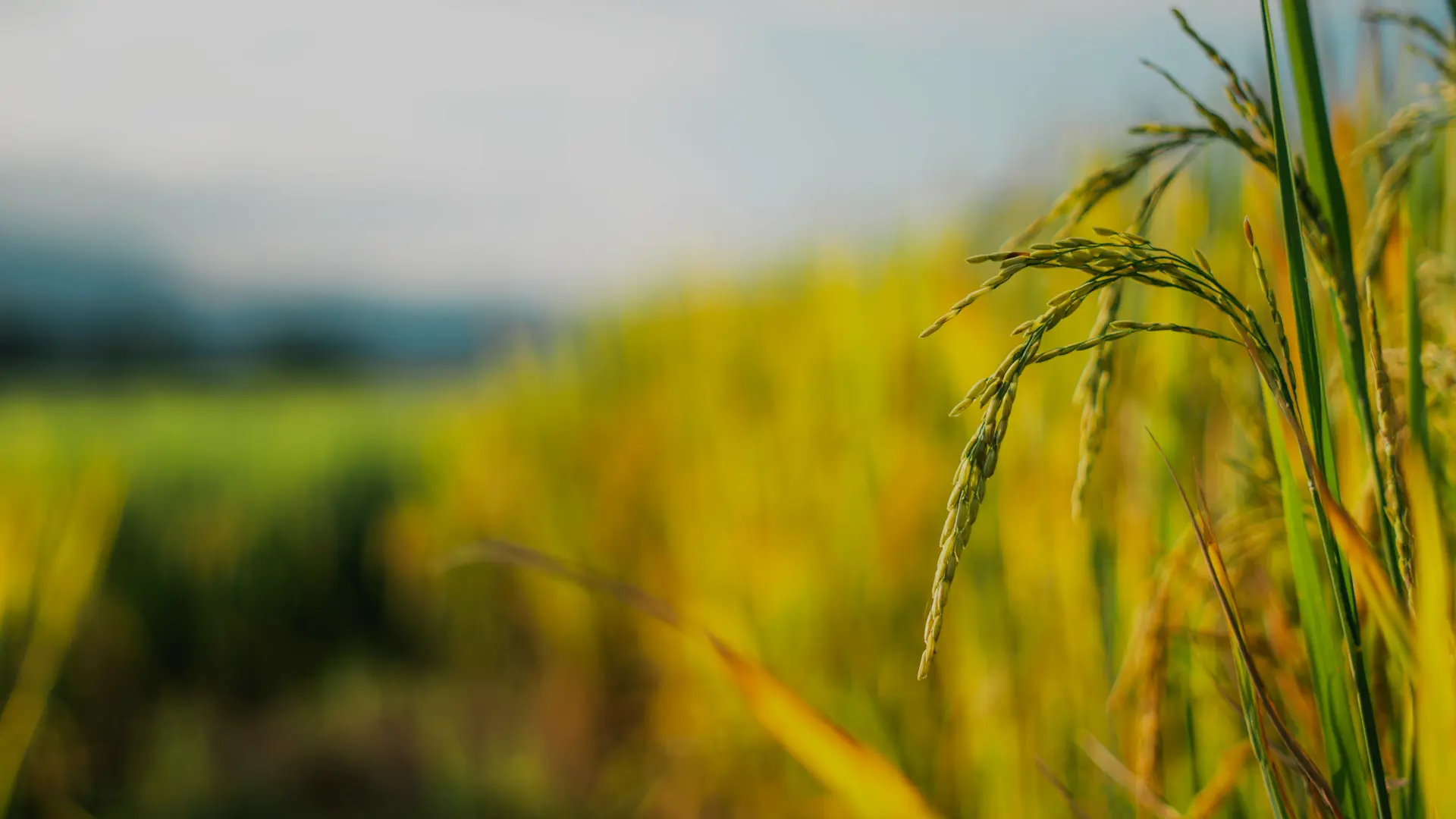We need to transform rice production.
Rice is vital to global food security. This crop provides sustenance to approximately half of the world's population (USDA, 2023) and ranks as the third-largest crop globally in terms of harvest acres (FAO, 2022). However, climate change poses significant challenges to rice cultivation, affecting both the crop itself and the livelihoods it supports. Changing weather patterns, extreme events, and rising temperatures disrupt planting schedules and reduce yields.
Not only is rice affected by climate change, but it also plays a significant role in the problem itself. Rice farming accounts for approximately 12% of global methane emissions and consumes around 40% of global irrigation water (World Wildlife Fund, 2022).
Given both its importance and its relation to our climate, it’s essential that we explore sustainable rice production methods and ensure financial support for those explorations.
We need a transformation in rice production to enhance resilience in our food systems. However, this journey is complex, with several barriers. One of the more significant barriers is that a vast majority of rice is produced by smallholder farmers, and there has been a lack of measurement, reporting, and verification (MRV) systems that enable transparency and measurement of climate impacts at scale for this crop.
Fortunately, technology offers a solution to unlock climate finance through scalable MRV platforms for global rice production.
MRV plays a crucial role in mobilizing climate finance.
MRV platforms have the capability to reduce or remove many barriers faced by the rice sector in unlocking climate finance:
- Monitoring for Irrigation Management: Changing rice irrigation management from continuously flooded fields to alternate wetting and drying (AWD) has been proven to be effective in reducing greenhouse gas (GHG) emissions. However, widespread adoption and support through climate finance has been limited due to the complexity of monitoring and quantifying the impacts at different scales, ranging from individual rice paddies to larger landscapes. MRV platforms can monitor the adoption of these practices in more efficient, cost-effective ways and across different scales, which enables more efficient and streamlined monitoring for practice adoption.
- Remote Sensing-Based Applications: MRV platforms use remote sensing technology to map individual rice paddies. This allows for accurate tracking of changes in water management practices, such as the adoption of AWD, which reduces methane emissions compared to continuous flooding. Tracking these changes can help us understand the impact of different water management practices and quantify the effects of growers adopting climate-smart practices.
- Quantifying GHG Interactions: A key aspect of a well-developed MRV platform is its ability to quantify the interactions between water management practices and GHG emissions. For example, AWD reduces methane emissions, but can lead to increases in nitrous oxide emissions under specific conditions. Our DNDC process model was developed to capture these interactions and is well suited for quantifying changes in water management impact on net GHG emissions.
- Meeting Carbon Market Standards: To attract climate finance, emissions reduction estimates must meet the stringent requirements of voluntary carbon markets. MRV platforms provide quantitative uncertainty in GHG emission reduction estimates, ensuring compliance with these standards.
- Accounting for Local Variability: MRV platforms capture the impact of local weather and soil conditions on GHG emissions and emission reductions. This level of specificity and the use of region-specific data is essential for tailoring climate-smart practices to specific regions and understanding the true outcomes of those practices across the globe.
- Assessing Yield and Resilience: MRV platforms assess the impact of changes in management practices on rice yields and the overall resilience of rice value chains. This holistic view helps producers make informed decisions for sustainable rice production.
Monitoring practice changes, accurately and transparently quantifying the outcomes of those practices, and helping growers see the benefits of those practices on their operations can all build credibility and increase adoption rates for climate-smart rice production. Increased credibility and adoption often leads to increased demand for — and investment in — rice programs, which can in turn bring even more farmers and acres into the fold. MRV platforms like Regrow’s serve as the gear that turns the engine of practice investment and adoption.
Scaling agriculture resilience in the rice value chain
Regrow is at the forefront of the revolution in sustainable rice production and understanding its outcomes. Tools like our MRV platform empower organizations to plan, execute, and measure science-driven initiatives to expand climate-positive agricultural practices and reduce greenhouse gas emissions.
As a Silver Sponsor of the International Rice Congress, Regrow is actively engaged in an open dialogue about the unique challenges of rice production worldwide. At the congress, Regrow will outline how our MRV platform aligns with the key characteristics needed to support climate-smart finance investments in sustainable rice production at scale. We also plan to discuss the potential for aggregating smallholder farmer plots into projects that can drive meaningful reductions, so that we can establish mechanisms for the equitable distribution of revenue across farmer groups.
We look forward to discussing the ways in which we can support sustainable rice investments, while integrating smallholder farmers into these programs, through plenary panels and breakout sessions.
Sustainable rice production is not a choice.
In the face of climate change, sustainable rice production is not just a choice but a necessity.
Unlocking climate finance is the key to scaling climate-positive practices in the rice sector. MRV platforms, like the one we offer at Regrow, are essential tools for monitoring, reporting, and verifying the impacts of these practices.
By adopting such technologies and fostering partnerships, we can build resilience in our rice systems, ensuring food security for a growing global population while mitigating the environmental impact of rice cultivation. Time is of the essence, and we must come together to adapt and strengthen these systems, converging on sustainable and climate-resilient rice production practices. The future of our food systems — and one of the most significant crops in that system — depends on it.
Explore our MRV and see our work in the rice sector with Kellanova.
Sources
*Rice sector at a glance. USDA ERS - Rice Sector at a Glance. (2023, September 27). https://www.ers.usda.gov/topics/crops/rice/rice-sector-at-a-glance/
** FAO. 2022. World Food and Agriculture – Statistical Yearbook 2022. Rome. https://doi.org/10.4060/cc2211en
*** Julia Kurnik and Katherine Devine, W. W. F. (2022, April 12). Innovation in reducing methane emissions from the food sector: Side of Rice, hold the methane. WWF. https://www.worldwildlife.org/blogs/sustainability-works/posts/innovation-in-reducing-methane-emissions-from-the-food-sector-side-of-rice-hold-the-methane



